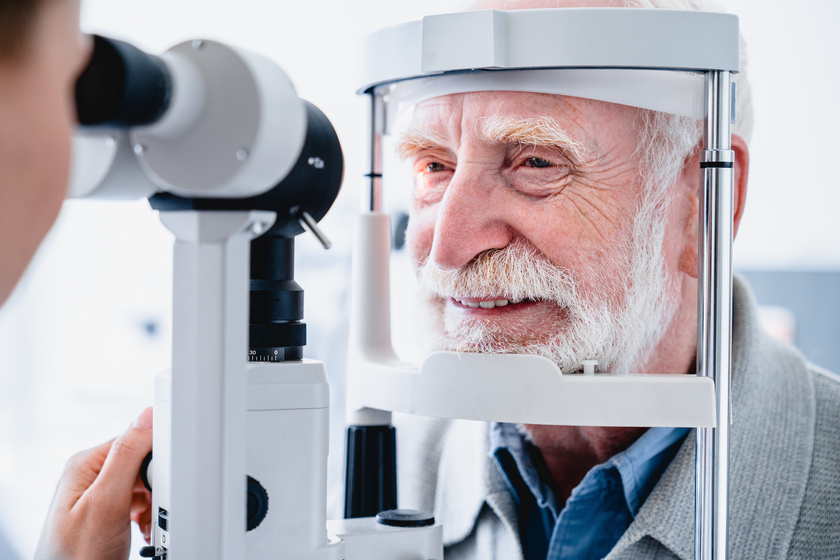
Alzheimer’s disease is the most common form of dementia. The brain changes that cause Alzheimer’s start to occur many years before early symptoms, such as memory loss and trouble retaining new information, begin to show.
There’s no cure for Alzheimer’s. However, early detection can help prepare you for its progression. Early diagnosis may also give you an incentive to pursue activities, such as learning a new language, that may boost brain health.
Toward that end, a specific type of eye exam has been shown in studies to detect changes in the retina that may signal Alzheimer’s disease.
Can an eye exam detect Alzheimer’s?

If you routinely see an ophthalmologist, you’re probably used to getting standardized eye exams that assess vision and look for conditions like glaucoma and macular degeneration. However, these tests don’t analyze the eye for evidence of Alzheimer’s disease.
But there is a test, called optical coherence tomography angiography (OCTA) — a relatively new, noninvasive imaging test — that allows your ophthalmologist to view tiny blood vessels in the back of your eye. This test can assess:
- deterioration in the retina
- disparities in blood vessel density
- capillary blood flow
A 2022 review, Trusted Source of multiple studies on Alzheimer’s disease, found that the changes in retinal blood vessels identified by the OCTA test may be a biomarker for early Alzheimer’s disease. Researchers noted a deterioration in the blood vessels of the retina occurs when similar changes are happening in the brain.
In people with symptomatic Alzheimer’s, retinal changes found in studiesTrusted Source included:
- reduced macular blood vessel density
- reduced macular perfusion density
- reduced ganglion cell-inner plexiform layer
While more research is needed, these findings are compelling and may be a significant reason for people concerned about Alzheimer’s to request an OCTA exam.
How is optical coherence tomography angiography (OCTA) performed?
OCTA is a noninvasive eye exam that uses light waves reflected off red blood cells to create 3D images of the blood vessels in different areas of the eye, usually the retina. This painless exam takes about 10 minutes to perform.
Your doctor may dilate your eyes by putting medicated drops into your eyes that cause your pupils to dilate or stay expanded. This is painless for most people, but your eyes may be light-sensitive for a while.
You should be able to drive yourself home after your eye exam and OCTA, but, if your eyes have been dilated, you’ll need to wear sunglasses. Your doctor may have disposable sunglasses if you need them.
During an OCTA, an optical technician, optometrist, or ophthalmologist will ask you to place your chin in a chin rest in front of a machine. You’ll need to keep your eye open as you look at an image — something like a small picture or blinking dot. While you’re looking at the image, the machine will scan your eye without touching it.
What is Alzheimer’s disease?
![]()
Alzheimer’s disease is a progressive, degenerative type of brain disease. It’s caused by cell damage and deteriorating changes in the brain. Alzheimer’s erodes memories and thinking skills. It’s a fatal condition that progresses over the course of many years.
Aging is the most prevalent risk factor for Alzheimer’s disease. It’s not fully understood why some people get Alzheimer’s and others don’t. It’s known that Alzheimer’s disproportionally affects women and Communities of Color. However, anyone can get Alzheimer’s disease.
What are the symptoms of Alzheimer’s disease?
Alzheimer’s symptoms worsen over time. The damage caused by early onset Alzheimer’s occurs in the area of the brain where learning takes place. Early symptoms that you or your loved ones may notice include:
- inability to retain new knowledge
- confusion
- memory loss
- trouble performing daily living skills and familiar tasks
- disorientation
- impaired judgment
- inattention to personal hygiene
- wandering and getting lost
- personality changes
As the disease progresses, damage spreads to areas of the brain that handle sensory processing, language, reasoning, and conscious thought. More serious symptoms can include:
- marked memory loss
- inability to self-modulate behavior
- trouble with balance and coordination
Late-stage symptoms affect the entire body and can include:
- problems with autonomic (involuntary) functions, such as breathing and heart rate
- inability to communicate
- severe muscle weakness that impairs eating, walking, and other bodily functions
Frequently asked questions
Are Alzheimer’s disease and dementia the same thing?
Dementia is an umbrella term that refers to deficits in mental ability severe enough to interfere with daily life. There are many different types of dementia. Alzheimer’s disease is the leading cause of this condition. However, not everyone with dementia has Alzheimer’s disease.
How common is Alzheimer’s disease?
According to the Centers for Disease Control (CDC)Trusted Source, 5.8 million Americans had Alzheimer’s disease in 2020. People are usually diagnosed with this disease after age 60. The number of people with Alzheimer’s doubles every 5 years after age 65.
Does Alzheimer’s run in families?
Genetics and family history may play a role in some occurrences of this disease. However, you’re not destined to get Alzheimer’s, even if your parent or sibling has it. There’s still so much unknown about this condition. There’s also some evidence that healthy lifestyle factors such as exercising, eating a good diet, and limiting alcohol may reduce your risk.
The takeaway
The optical coherence tomography angiography (OCTA) test, a specific type of noninvasive eye exam, can be used to identify retinal changes which may indicate early Alzheimer’s disease.
While compelling, more research is needed to determine if this test can be used to diagnose Alzheimer’s in people who have it, prior to the appearance of symptoms.
Credits to the original link: https://www.healthline.com/health/alzheimers/early-signs-of-alzheimers-are-in-the-eye#octa-test
